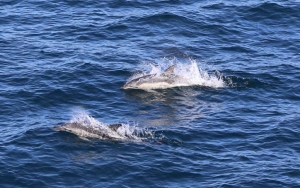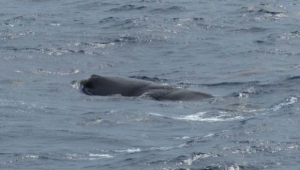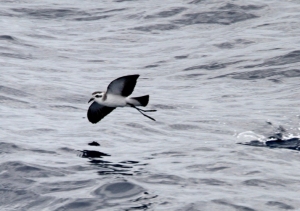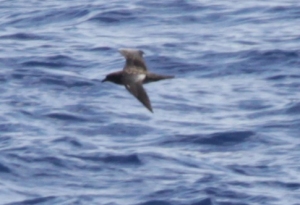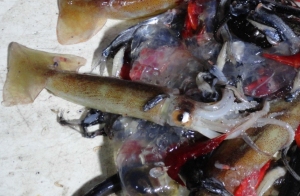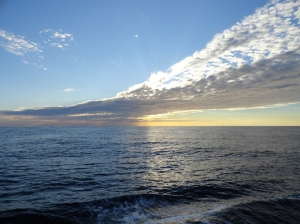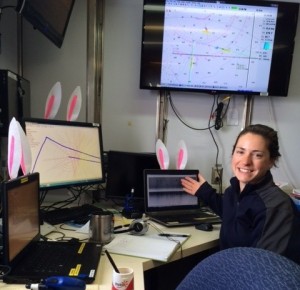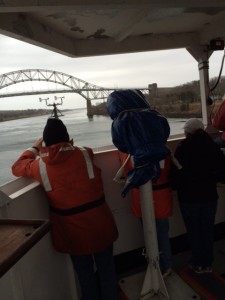Category Archives: AMAPPS
The National Oceanic and Atmospheric Administration (NOAA), Bureau of Ocean Energy Management Regulation and Enforcement (BOEMRE), US Fish and Wildlife Service (FWS) and the US Navy are working to develop models and associated tools to provide seasonal, spatially-explicit density estimates incorporating habitat characteristics of marine mammals, turtles and seabirds in the western North Atlantic Ocean. Underlying these will be the collection of broad-scale data over multiple years on the seasonal distribution and abundance of these taxa using direct aerial and shipboard surveys conducted by scientists from NOAA Fisheries and the US Fish and Wildlife Service.
Bad weather ahead on leg III
August 10, 2016:
The 3rd leg of the AMAPPS abundance survey on the Henry Bigelow began today, as we departed the WHOI dock around 10:00am. The day got off to a rocky start since one of our science crew had to get off the ship at the last minute; she had been sick the past few days and unfortunately was not able to sail with us. Her departure dampened spirits as we left the dock, but it couldn’t be helped.
We hit the ground running today, arriving at our first survey area at 1:00pm, west of Nantucket. Since most of the transect lines in that area had been covered on the previous leg, we only had about 4 hours of surveying left to do before heading offshore. Unfortunately, the weather was not as cooperative as I had hoped, and after a couple of hours, we had to break off effort due to rain and sea state. We’re heading out to the shelf break now, with the plan to start tomorrow morning just south of the Great South Channel. The weather looks rough for the next few days, but we’ll make the most of it!
Cheers,
Danielle Cholewiak & the Bigelow team
Surveying for Marine Mammals, Turtles and More
Report from the AMAPPS Bigelow survey on 6July2016, our first bad weather day.
The 2016 AMAPPS (Atlantic Marine Assessment Program for Protected Species) marine mammal and sea turtle abundance survey started on 27 July 2016. This is a multi-platform survey involves two ships (the NOAA ships Henry B. Bigelow and Gordon Gunter) and two NOAA Twin Otter airplanes that will together survey waters along the entire US Atlantic coast from Maine to Florida and from the shore line to the 200 nautical mile US exclusive economic zone (EEZ) during 27 July – 28 Sept 2016. These surveys are being led by the Northeast and Southeast Fisheries Science Centers and funded by the Bureau of Ocean Energy Management (BOEM), the National Marine Fisheries Service (NMFS, also known as NOAA Fisheries), the US Navy and the US Fish and Wildlife Service (USFWS). In addition, our Canadian colleagues are conducting an extensive aerial survey using two planes during the same time period covering Canadian waters around Nova Scotia and Newfoundland . One other large scale cetacean abundance survey, known as SCANS (Small Cetaceans in European Atlantic waters and the North Sea) III is also taking place this summer around Europe.
There are 2 teams of visual observers on the AMAPPS Bigelow shipboard surveys that are scanning the waters using high powered binoculars looking for whales, dolphins, turtles, and seals and using line transect sampling methods. During 28 Jun – 4 Jul 2016 we covered about 575 nautical miles of track lines off the coasts of Virginia and Delaware and have already seen more than 2000 animals from 15 species. So far the most common species are common dolphins and striped dolphins. We have been in warm Gulf Stream waters where we have seen spinner dolphins (below).
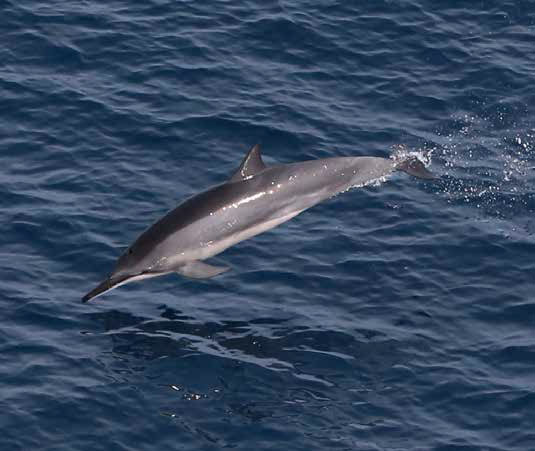
In the deeper waters we have already seen three species of beaked whales (see below for more on these species). One of the most spectacular sightings we had was a group of about 24 false killer whales feasting on a large fish.
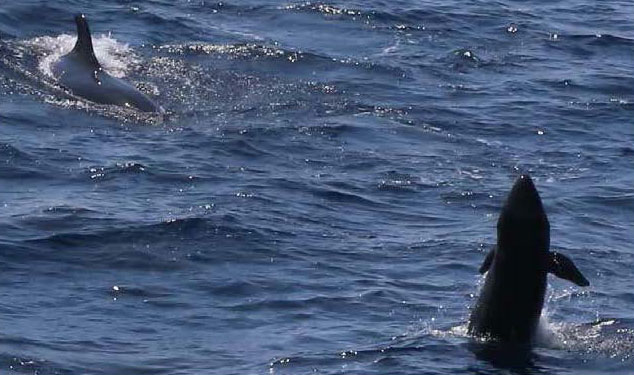 Photos of spinner dolphin and false killer whales by Richard Holt under MMPS permit number 17355-01.
Photos of spinner dolphin and false killer whales by Richard Holt under MMPS permit number 17355-01.
In addition to searching for marine mammals there is a team of observers dedicated to searching for birds. The seabird team, conducting a modified 300 meter strip transect, found 390 birds representing 19 species, so far. We averaged about seven species per day, the exception being 4 July on line 25 when we found a remarkable 12 species including our first White-faced Storm-Petrel and South Polar Skua of the cruise. Furthermore, 961 seabirds were counted in six multi-species feeding flocks, consisting almost entirely of the three expected shearwater species: Cory’s, Great, and Audubon’s Shearwaters. These feeding flocks were almost all farther offshore in warmer water, presumably associating with feeding tuna or other predatory fish. Highlights, and there always are highlights of one sort or another, were three Trindade (aka Trinidade) Petrels, a single Black-capped Petrel (all about 170 to 190 nautical miles east of Cape Charles/Cape Henry) and a confiding immature Brown Booby (below) wandering somewhat farther north than expected. The seabird team remains on a high level of alert as we survey the outer lines, eager for what other warm water species we might find out here. We collectively cry “East!” and the farther east (or southeast), the better. It’s all about the Gulf Stream, isn’t it?
 Brown Booby that used the Bigelow as a resting spot. Photo by Michael Force
Brown Booby that used the Bigelow as a resting spot. Photo by Michael Force
There is also a team of scientists listening for animals using hydrophones that trail behind the ship. We’ve had a air diversity of species during this first week of the AMAPPS cruise. Sperm whales seem to be heard almost everywhere, and we’ve had some of their other click types besides the usual (ie: creaks and codas). We had a really good day where the visual team was able to spot and bring us to various different groups of dolphins and give us the opportunity to collect really high quality unambiguous recordings. We also managed in one week to collect recordings on the three species of beaked whales that we’ve encountered in the past (Cuvier’s, Gervais’, and Sowerby’s). The sonobuoys are being deployed every night to listen for the presence of baleen whales (which the array cannot detect). So far we have not heard baleen whales, but have detected sperm whales and dolphins.
Lastly, to learn more about the ecosystem that these marine mammals and turtles are living in we have scientists collecting data on oceanography and plankton. These scientists work at night utilizing a range of instruments, imaging systems, and nets. For oceanographic properties of the water like temperature, salinity and density, a CTD (Conductivity, Temperature, Depth) is lowered through the water column. The EK60 is an active acoustic instrument on the hull of the ship that pings in 5 different frequencies to detect animals in the water column ranging in size from 1cm plankton to adult fish. Phytoplankton, individual celled plants less than 0.5mm in size, are being imaged from the surface water by an Imaging FlowCytobot. The zooplankton, animals 5mm to 2cm in size that live in the water column, are being imaged by a towed Video Plankton Recorder. Zooplankton is also being sampled using two net systems: a 61cm bongo, which is a standard plankton net, and a 2m x 1m neuston modified with weights to sample from the surface to 25m depth. The samples collected with the nets will have all the zooplankton and larval fish in them identified back at the lab, but we will especially be looking for bluefin tuna larvae, which were not previously thought be in the study area. Out here in the Gulf Stream, salps, a gelatinous type of zooplankton, have been the most frequently seen species in the nets. In fact each net may have over a gallon of salps that must be sieved out and discarded before the sample is preserved.
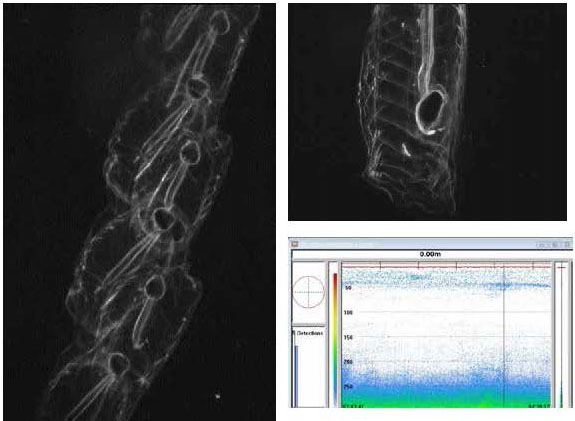
Above: Images of the most common salp, Salpa aspera, in its chain form and solitary form taken by the Video Plankton Recorder, and an image of a layer of salps around 50m depth as seen by the 200kHz transducer of the EK60.
The AMAPPS Bigelow Team, Leg I
Whale Alert!
Listening for beaked whales…
29 July 2013
Aboard the Henry Bigelow, Days 5-6
Although the end of our cruise brought a lot of nasty weather, which really inhibited the visual survey effort, we did have some good luck with our passive acoustic efforts. We have been towing a hydrophone array 300 meters (~900 feet) behind the ship, listening for anybody who is talking underwater. Yesterday, we ran a transect that crossed over some sites where we had previously seen beaked whales, and lo and behold – we picked up several individuals on our hydrophones! Some of the echolocation clicks we heard belong to Cuvier’s beaked whales, one of the more studied among the beaked whale species. But then we got some clicks that we didn’t recognize, which was pretty exciting!
We can track individual animals by their echolocation clicks to see how far they are from the vessel. The difference in the time that their clicks are received at one hydrophone versus another allows us to calculate the direction that the clicks are coming from. The image on the top below shows the bearing (or direction) for several animals over time. The blue squares are several sperm whales that were foraging in the area, and the broken black line is from beaked whales! The spectrogram on the bottom shows the characteristics of one of the beaked whale clicks – in this case, showing a strong upsweep.
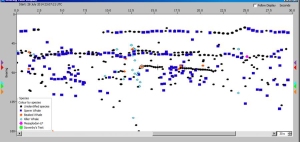
The bearing or direction for several animals over time. The blue squares are several sperm whales foraging in the area; the black broken line is from beaked whales. Courtesy Danielle Cholewiak, NEFSC/NOAA
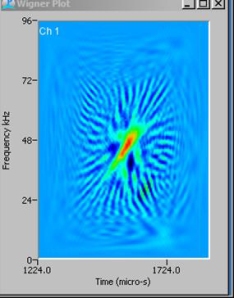
Spectrogram showing characteristics of beaked whale clicks – note the strong upsweep. Courtesy Danielle Cholewiak, NEFSC/NOAA
It’s hard to believe that our survey is over already. The scientific crew (17 of us in total) and the ship’s crew (21 on the boat) have been great and it’s been a pleasure to work with all of them. Hopefully we’ll be able to come out here again next year!
Danielle Cholewiak
Chief Scientist
AMAPPS HB14-03
So what have we seen offshore?
28 July 2013
Aboard the Henry Bigelow, Days 2-5 mammal & bird sightings
Our survey is short, but we’ve packed in as much as we could in our few days on the vessel. The visual observer teams were on-effort pretty much all the time between sun up and sun down each day. We started scanning for animals pretty much as soon as we left Newport, and collected data on cetaceans seen during transit until sunset. Balaenopterids, particularly fin whales, made up the majority of sightings on that route. Common dolphins were also nearby, yet few chose to approach and give us a better look. The common dolphins pictured were the exception. Throw in some basking and thresher sharks and all in all it was a beautiful day to finally be at sea.
Our diversity of species was the highest on the 26th, including sperm whales and pilot whales, Risso’s, bottlenose, spotted and striped dolphins. Oh, and we got our beaked whales! Cuvier’s and Sowerby’s were documented, along with distant Ziphiids that could not be identified to species. As the day progressed we spotted more Sowerby’s and attempted focal follows.
Unfortunately, on Sunday our quest for Mesoplodonts was hampered as weather conditions deteriorated through the day. We had numerous sightings of Cuvier’s but no confirmed species identification for other Ziphiids. Sperm whales, Risso’s dolphins and smaller Delphinids were encountered and again, most were camera shy.
Waking up on Monday, it was apparent that seeing any animals at all would be problematic. We reduced visual effort considerably due to high wind and seas, spray, and rain showers. From inside the bridge we searched for any animals that just might stand out against the waves and foam. Sadly, what we mostly saw were waves and foam, and gloomy skies. The seas continued to build throughout the day, so we had to abandon the trackline we were surveying and work our way to the northeast, down-swell. Monday night was really bumpy – nothing like 30kt winds to toss one around a bit, but the ride home for the end of the cruise looks more promising.
Seabird update:
The bird team jumped right in where we left off this spring and hardly missed a beat. Or, actually, that should be not missing a bird (we don’t miss birds out here, you know). But my oh my, what a difference a couple of months can make. With just three days so far on this survey, we’ve already tallied 395 birds of 17 species. You read that right: seventeen! Taking the top three spots in terms of overall abundance and detection frequency were the expected summer visitors to the northwest Atlantic: Wilson’s Storm-Petrel (183), Cory’s Shearwater (81), and Audubon’s Shearwater (27). These are the bread-and-butter of the summer seabird survey sandwich around here. But we want our cake and eat it too—the crème de la crème for those with exotic tastes—the dapper White-faced Storm-Petrel. We certainly weren’t expecting to find nine in only three days! These gorgeous and unmistakeable storm-petrels with their swinging pogo-stick flight, effortlessly bouncing across the ocean, are considered to be rare summer visitors here from the east Atlantic. And here they are, being found almost daily over deep warm water seaward of the shelf break, beyond the reach of most day trips. Only on these surveys can we get a better understanding of their true distribution and abundance.
Taking top spot this week was, not surprisingly, a seabird in the genus Pterodroma. Seabirds in this genus tend to draw a lot of attention to themselves by virtue of being hard to find thanks to their propensity to remain far from land—very far—often not approaching any closer to the continent than the shelf break. Hence, seeing one tends to generate a fair amount of excitement. The Trindade Petrel seen on Saturday was the first live one seen in New England waters (one washed up dead on a Maine beach this spring). The occurrence was documented with identifiable photographs (these birds don’t linger for very long) thanks to Jessica Aschetinno’s snappy trigger finger. This species nests on several small islands off Brazil and wanders north, entering the Gulf Stream, where most are found on spring and early summer commercial birding trips off North Carolina.
Other noteworthy warm-water species seen this week include three Black-capped Petrels, and several Band-rumped Storm-Petrels.
Danielle Cholewiak
Chief Scientist
AMAPPS HB14-03
Off for a beaked whale survey!
26 July 2013
Aboard the Henry Bigelow, Day 2
After a series of delays, we finally departed Newport, RI, the afternoon of July 25th and headed offshore for a very short survey focused on beaked whales! We only have a handful of days in which to work, so we hope to make the most of them. We transited out for about 20 hours, hitting our target area off Georges Bank early Saturday morning. Saturday was quite the day! In the wee hours of the morning, we started off with oceanographic sampling at one of the nearby EcoMon stations, where we did a CTD and bongo cast. As soon as we had daylight, our next order of business was to deploy a passive acoustic recorder (an AMAR, or autonomous multichannel acoustic recorder), that will be out for a year listening for everything from beaked whales to baleen whales. We had picked a site near Lydonia Canyon, so we did some scouting to find an area with our target depth, about 800m (or 2400 ft). At about 6:30am, the Bigelow crew delicately lowered the recorder, its floats, and its 400 lbs of weight over the side of the vessel and away it went! Now it’s sitting on the bottom and recording. Hopefully it will still be there in a year when we go back for it, and it will have a lot to tell us about seasonal occurrence of animals in that area.
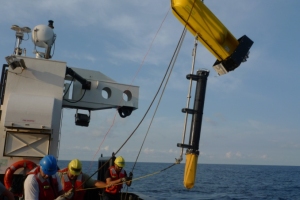
An autonomous multichannel acoustic recorder, or AMAR, is deployed from the Bigelow. Photo by Danielle Cholewiak, NEFSC/NOAA
That was just the start to our day! We surveyed for beaked whales all day long. We found scattered groups of dolphins and sperm whales, but didn’t have a lot of luck with beaked whales until about 5:00pm, when we hit a patch of glassy water near the shelf break and suddenly found ourselves in the midst of Sowerby’s and Cuvier’s beaked whales. That was exciting for everyone! We worked with them until dusk, collecting data on surfacing rates of groups and towing the hydrophone array, until we couldn’t see them anymore. Finally, around 7:30 pm, we broke off our effort and the day group took a well-deserved break. But the day still wasn’t over! At that point, we switched our effort over to oceanography, prey sampling, and passive acoustics. We spent the night in the same area where we had seen the beaked whales, deploying a small mid-water trawl to a depth of about 500m to target the deep-sea fishes that our beaked whales might be foraging on. It was the first time deploying this net off the Bigelow, and the first time towing through such a deep layer! The tow revealed an interesting composition of deep-sea fishes, including viper fish, hatchet fish, snipe eel, and Ilex squid.
Before long, dawn was upon us again, as we got ready for another 24 hours of surveying, listening, and sampling. We’ll send more updates tomorrow about the cetacean and bird activity out here!
Daniele Cholewiak
AMAPPS HB14-03
Rare sightings: A Spectacular Week for the Seabird Team
This turned out to be a spectacular week for the seabird team. We logged 1101 seabirds of 22 species, about a 30% drop in diversity from last week, but several of these were new for AMAPPS 2014. Without question, the highlight this week occurred during our transits across Georges Canyon, at the far eastern edge of Georges Bank. Here we found two seabirds, one rarely seen in Canada — a Black-capped Petrel—and the other, a Bermuda Petrel – is hardly seen anywhere. The Bermuda Petrel (IUCN status: Endangered) wandered down the starboard side and sent shock waves across the flying bridge.
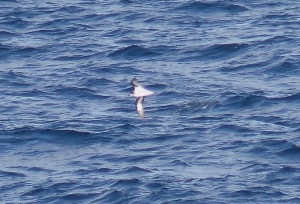
The Bermuda petrel is commonly known in Bermuda as the cahow, a name derived from its cries. Thought to be extinct for more than 300 years, this nocturnal ground-nesting seabird is the national bird of Bermuda. Photo credit: Mike Force, NEFSC/NOAA
This species, which nests only on isolated rocks and islets off Bermuda, was presumed extinct in 1620. For 300 years that certainly seemed to be the case until a specimen, found in 1906, was finally identified 10 years later. When breeding was confirmed, in 1951, there were an estimated 17 or 18 breeding pairs, which, through intensive conservation and translocation efforts, has increased to about 103 breeding pairs. The world population is currently estimated to be 300-350 birds, perhaps as high as 500.
Finding one in the vast expanse of the north Atlantic is akin to winning the lottery. Our sighting represents perhaps the first or second confirmed sighting for Canada. Fortunately, we were able to get a few poor quality photos to confirm the identity. It was simply remarkable. We can all go home now!
Michael Force and Nicholas Metheny
GU14-02 Leg II
Atlantic Marine Assessment Program for Protected Species (AMAPPS)
Cetacean and Turtle Abundance Spring Survey
Oh Canada!
Day 13: 19 April.
We’ve arrived at our Northeast most tracklines over the Hague line and into Canada. This area is great habitat for beaked whales and we were hoping to see a lot. Though the weather was less than ideal, we had over 70 individual sightings, the most sightings of this leg. As expected, many beaked whales were seen with lots of breaching activity, even as close as 300 meters from the ship. In addition, there were several common dolphins, with one large group of approximately 300 individuals, striped dolphin, Risso’s dolphin, finback whales, humpback whales, and one sighting of a blue whale.
On the seabird front, there were many individual sightings with puffins, dovekies, gulls, Leach’s storm-petrels, sooty shearwaters, Northern gannets, and great looks at several jaegers.Another black-capped petrel sighting was particularly interesting so far north in Canadian waters.
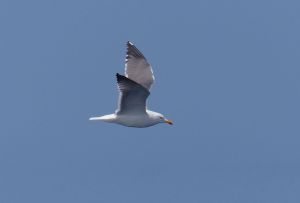
A Lesser Black-backed gull. Photo credit: Mike Force
The deep water enabled continuous towing of the acoustic array throughout the day while two MARUs were also deployed. Oceanographic sampling via CTDs and bongo fine mesh nets continues as well as our first deployment of the video plankton recorder. More to come, next blog…Bermuda petrel, oh ya!!
Gina Shield
GU14-02 Leg II
Atlantic Marine Assessment Program for Protected Species (AMAPPS)
Cetacean and Turtle Abundance Spring Survey
Right Whale Minefield
Aboard the Gordon Gunter:
Days 9 – 11. The past 48 hours have been slow going. Although we attempted to work in the building winds and sea state of an approaching storm system, conditions became too rough so we ended operations and headed inshore for calmer waters. Our new destination was Cape Cod Bay, by way of the Cape Cod Canal, where we anchored up just of Provincetown, Massachusetts, to wait out the weather. As the sun set that evening, 30 or so right whales could be seen near and far breaching, splashing and flipper displaying.
On Thursday, 17 April, we pulled anchor and began a 29-hour steam that will take us out to the Northeast peak of George’s Bank to our eastern most tracklines and into Canadian waters. On our way out of the bay, we were again treated to the sight of many right whales. It was a literal minefield as we encountered no less than 20 whales, some surfacing close to the ship directly in our path. In a world where most things must get out of its way, several whales seemed unaware of the impending approach of the ship and the potential danger. It was easy to see why mariners must use caution around these large slow-moving whales. We were able to photograph at least 5 individuals with the hopes that many will be individually identified. Hopefully the weather will improve in the days to come as again we head to the shelf edge and canyons that we’ve been dying to survey.
Gina Shield
GU14-02 Leg II
Atlantic Marine Assessment Program for Protected Species (AMAPPS)
Cetacean and Turtle Abundance Spring Survey

